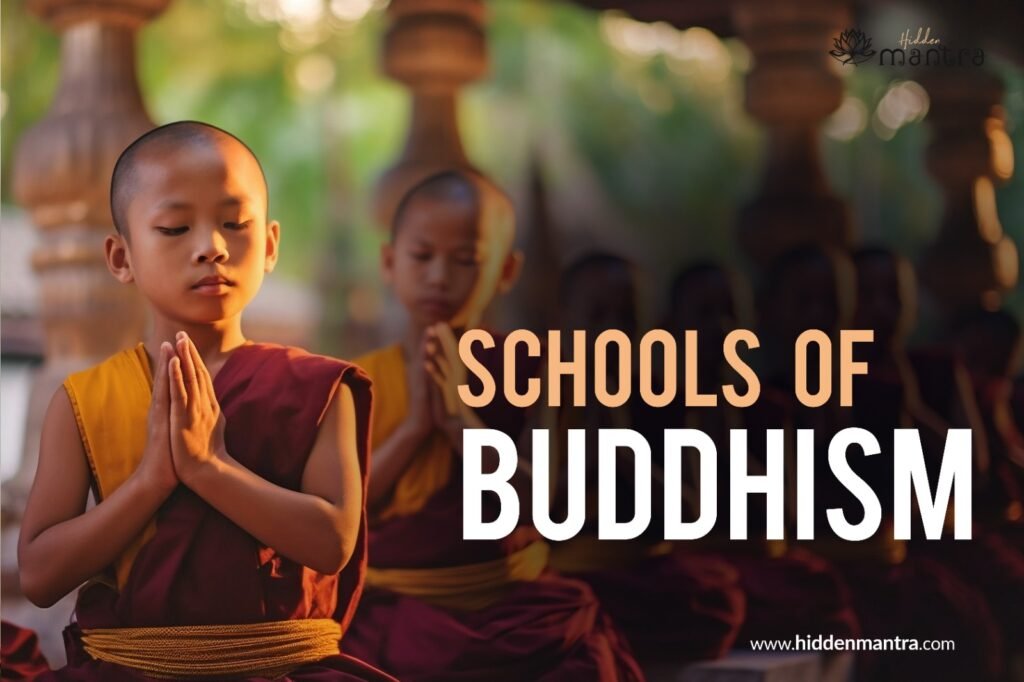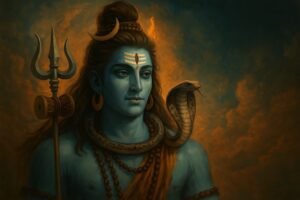Table of Contents
ToggleIf you are interested in knowing about the various schools of Buddhism? Would you like to learn about the lessons derived from these schools?
Buddhism, also known as Buddha Dharma, is a way of life founded on the teachings of the great Buddha. It is a significant spiritual tradition in India with deep philosophical roots and practical approaches, catering to different personalities and cultural backgrounds.
At “HiddenMantra,” our commitment is to deliver detailed knowledge about the different philosophies shaping each schools of buddhism.
In this blog, you will find complete information about Buddhism schools. This blog covers the topic comprehensively from top to bottom.
What is a School of Buddhism?
After the death of Siddhartha Gautama Buddha, Buddhism schools developed based on his teachings. Each school has its own way of understanding and practicing the teachings of Buddha. These variations have come about because of differences in culture, location, and beliefs.
The philosophy of Buddhism is a collection of ideas that try to explain the nature of life and how people should live. It is a detailed and diverse tradition, and it is one of the oldest in the world.
Buddhism started in India and spread around the world. It’s one of the world’s major and oldest religions. Buddhism includes teachings from Siddhartha Gautama, also called the Buddha, and has many different schools and ideas. It is a mix of philosophy, psychology, and ethics.
There are main four schools of buddhism are there Each school has its unique philosophy and beliefs next we learn what are they
Four schools of buddhism
Buddhism is a profound spiritual and philosophical tradition that began in Asia and has evolved into four main schools: Theravada, Mahayana, Vajrayana and Zen. Each school has its unique teachings and philosophies, yet they all uphold foundational Buddhist beliefs such as the Four Noble Truths, the Noble Eightfold Path, and the four Universal Laws.
Here’s a clear and concise overview of these four major schools of buddhism to help readers understand their distinct features and philosophies.
Theravada Buddhism
Theravada Buddhism is one of the oldest types of Buddhism, following the Buddha’s original teachings. It’s all about finding inner peace through meditation, being ethical, and gaining wisdom.
People in countries like Sri Lanka, Thailand, and Myanmar mainly practice it. By following Theravada Buddhism, individuals aim to find true happiness and break free from suffering.
Mahayana Buddhism
Mahayana Buddhism extends the goal of enlightenment to all sentient beings. It promotes the Bodhisattva ideal, where individuals strive for enlightenment to help others. Followers are encouraged to adopt this path, focusing on compassion and selflessness, guided by various sutras.
This school has a strong presence in China, Japan, Korea, and Vietnam.
In Mahayana Buddhism, there are six key qualities called the Six Perfections. These are: being generous, being good, being patient, working hard, focusing well, and understanding deeply.
These qualities help Buddhists become enlightened and help others too.
Vajrayana Buddhism
Vajrayana Buddhism, also known as Tibetan Buddhism, uses rituals and meditation for fast enlightenment. Practitioners develop deep focus and see sacredness in everyday life.
It’s mainly practiced in Tibet, Bhutan, Mongolia, and parts of India and Nepal, with growing interest in the West.
Zen buddhism
Zen Buddhism, originating in China as Chan and flourishing in Japan, emphasizes direct experience and meditation over studying doctrines. Practitioners seek enlightenment through seated meditation and mindfulness in daily life, going beyond conventional logic to understand reality directly.
Studying Zen develops mindfulness, presence, and a deeper awareness of the present moment. Regular meditation and contemplating koans promote a peaceful mind, clarity, discipline, and resilience.
What is the difference between Mahayana Theravada Buddhism
Theravada and Mahayana are two main types of Buddhism. Theravada, mostly in Southeast Asia, focuses on personal enlightenment through strict rules and meditation based on the Pali Canon. Mahayana, common in East Asia, aims to help all beings achieve enlightenment, using a wider range of teachings and practices.
Mahayana sees the Buddha as an eternal figure who can appear in many forms, while Theravada views him mainly as a historical teacher. Mahayana practices include various meditations and rituals, with more colorful art and celebrations, while Theravada is simpler and more conservative.
Importance of Schools of Buddhism
1.Cultural Diversity: schools of buddhism provide a spectrum of approaches, allowing for cultural adaptation. This diversity makes individuals from different backgrounds to connect with the teachings in a way that reflects with their cultural context.
2. Philosophical Exploration: Each school offers a unique lens through which to explore and understand the principles of Buddhism. This diversity allows for a detailed examination of Buddha’s teachings, fostering a richer understanding of the great path to enlightenment.
3.Individual Affinity: Different schools appeal to distinctive individuals based on their inclinations and spiritual aspirations. Some may find solace in the disciplined Theravada path, while others resonate with the compassionate approach of Mahayana. This variety enables seekers to find a path that aligns with their personal journey.
4. Catering to Diverse Learners: The different schools accommodate different learning styles. Some emphasize study of scriptures, while others focus on practices such as meditation or ritualistic ceremonies. This ensures that individuals with varied preferences and learnings can find a suitable path.
Advantages of Studying Buddhist Schools
1.Great Understanding: Studying different schools of buddhism provides understanding of Buddhism. It allows one to appreciate the variations in interpretation, deepening the knowlendge of the philosophy as a whole.
2.Cultural Appreciation: Delving into various schools of buddhism offers learning into the cultural contexts that have shaped each tradition. This cultural richness makes the appreciation for the global impact of Buddhism.
3.Personal Growth: Exploring diverse schools can be a journey of self-discovery. It allows individuals to identify with a specific tradition that aligns with their values, fostering personal, spiritual growth.
The Four Main Schools of Tibetan Buddhism
Tibetan Buddhism, known for its intricate rituals and vibrant traditions, is divided into four schools. Understanding the differences between these schools is crucial for appreciating the depth of Tibetan Buddhist philosophy. Let’s explore these further
what are the four main schools of tibetan Buddhism ?
Tibetan Buddhism has four major schools
- Gelug (1409).
- Nyingma (8th century)
- Kagyu (11th century)
- Sakya (1073)
1. Gelug School of Tibetan Buddhism
– Emphasizes disciplined monastic practices.
– Led by the Dalai Lama.
The Gelug School, also known as the “Way of Virtue,” is one of the major traditions within Tibetan Buddhism. Founded by Tsongkhapa in the 15th century, this school has played a pivotal role in shaping Tibetan Buddhist philosophy and practice. Let’s delve into the key aspects of the Gelug School
Founding and History:
- Established by Tsongkhapa in 1409 in Tibet.
- Emphasizes a return to the pure teachings of Buddha, combining elements of the Kadampa tradition.
Philosophical Foundation:
- Follows the Madhyamaka (Middle Way) philosophy, emphasizing the void nature of all phenomena.
- Integrates the Prasangika and Svatantrika Madhyamaka sub-schools, refining the understanding of emptiness.
Monastic Discipline:
- Known for its strict monastic discipline and adherence to Vinaya, the Buddhist ethical code.
- Monks follow a rigorous daily schedule of prayers, meditation, and study.
Emphasis on Study:
- Places a strong emphasis on scholarly study and intellectual pursuits.
- The monastic universities of Sera, Ganden, and Drepung are prominent centers for rigorous Buddhist education.
Leadership:
- The spiritual head of the Gelug School is the Dalai Lama, who is considered the emanation of Chenrezig (Avalokiteshvara), the Bodhisattva of Compassion.
- The Ganden Tripa, or spiritual leader of the Gelug tradition, oversees the monastic community.
Contributions to Tibetan Buddhism:
- Instrumental in unifying the various Tibetan Buddhist traditions under a common doctrinal framework.
- Known for its promotion of ethical conduct, compassion, and the pursuit of enlightenment.
Symbolism and Practices:
- The Gelug School employs various rituals and ceremonies, often incorporating esoteric practices from the Tantric tradition.
- The use of ritual implements, mandalas, and visualization practices are integral to their spiritual path.
International Impact:
- The Gelug School has gained international recognition, with Tibetan Buddhist centers around the world following its teachings.
- The Dalai Lama, as the spiritual leader of the Gelug tradition, has become a global ambassador for Tibetan Buddhism.
In summary, the Gelug School of Tibetan Buddhism stands as a beacon of scholarly pursuit, ethical living, and spiritual devotion. Its influence extends far beyond the Tibetan plateau, leaving an indelible mark on the global landscape of Buddhism.
2 . Nyingma School of Tibetan Buddhism
The Nyingma School, often acknowledged as the oldest school of Tibetan Buddhism, holds a unique and venerable position within the rich tapestry of Buddhist traditions. Let’s delve into the distinctive features that characterize the Nyingma School:
Oldest School of Tibetan Buddhism:
- The Nyingma School traces its origins back to the 8th century when it was founded by the revered Padmasambhava, also known as Guru Rinpoche.
- Its establishment coincided with the reign of King Trisong Detsen in Tibet, marking it as the oldest among the Tibetan Buddhist schools.
Rich Tradition of Tantric Practices:
- At the heart of the Nyingma School lies a profound appreciation for Vajrayana or tantric practices, emphasizing the transformative power of esoteric teachings.
- Guru Rinpoche, a key figure in the Nyingma tradition, introduced and propagated tantric Buddhism in Tibet, imparting a lasting influence on the school’s spiritual ethos.
Terma Tradition:
- The Nyingma School uniquely follows the Terma tradition, wherein concealed teachings are safeguarded by Guru Rinpoche and later unveiled by tertöns, individuals with the ability to reveal these hidden treasures.
- Terma teachings are discovered at specific times, believed to be auspicious for the benefit of all sentient beings.
Dzogchen:
- A focal point within the Nyingma School is the practice of Dzogchen, a contemplative and meditative path aimed at attaining a state of primordial awareness.
- Regarded as the highest and most direct route to enlightenment within the Nyingma tradition, Dzogchen embodies the essence of profound spiritual realization.
Monastic Structure:
- In contrast to other Tibetan Buddhist schools, the Nyingma School does not adhere to a centralized monastic institution. Instead, monks and nuns may choose various settings, including hermitages, centers, or larger monastic establishments.
Integration of Indigenous Beliefs:
- Throughout its history, the Nyingma School has embraced an inclusive approach, integrating indigenous Bon practices and beliefs into its tradition, resulting in a distinctive syncretism.
- This integration reflects the adaptability and openness of the Nyingma tradition to diverse spiritual influences.
Symbolism and Iconography:
- The Nyingma School employs unique symbols and iconography, such as sacred mandalas, thangkas, and ritual objects, which convey the profound spiritual narrative and cosmology of the tradition.
Living Lineage:
- Today, the Nyingma School remains a vibrant and living lineage, with practitioners across the globe.
- The transmission of teachings through successive generations ensures the preservation and continuity of the ancient wisdom encapsulated within the Nyingma tradition.
3 . Kagyu School of Tibetan Buddhism
The Kagyu School, a distinguished tradition within Tibetan Buddhism, is renowned for its emphasis on meditation and the transmission of wisdom through a lineage of enlightened masters. Let’s explore the unique characteristics that define the Kagyu School:
Meditation and Experiential Realization:
- The Kagyu School places a central focus on meditation as a transformative practice, emphasizing direct experiential realization over theoretical understanding.
- Practitioners within the Kagyu tradition engage in various meditation practices, cultivating a profound inner journey towards enlightenment.
Lineage of Enlightened Masters:
- The Kagyu School is notable for its unbroken lineage of enlightened masters, known as the Karmapas.
- The Karmapas are considered manifestations of enlightened activity, guiding the Kagyu tradition and providing spiritual leadership.
Founding and Historical Significance:
- Founded in the 12th century by the renowned yogi Milarepa and his disciple Gampopa.
- The Kagyu School traces its roots to the Indian yogi Tilopa, who transmitted profound teachings to Naropa, creating a lineage that later reached Tibet.
Mahamudra:
- A key teaching within the Kagyu tradition is Mahamudra, which translates to the “Great Seal” or “Great Symbol.”
- Mahamudra is a meditative approach that focuses on realizing the nature of mind, leading practitioners to direct experiential insight into ultimate reality.
Six Yogas of Naropa:
- The Kagyu School incorporates the Six Yogas of Naropa, a set of advanced tantric practices aimed at achieving spiritual mastery.
- These yogas include inner heat (Tummo), illusory body (Jalung), and dream yoga (Milam), among others, fostering a holistic approach to enlightenment.
Monastic Structure:
- While the Kagyu School has monastic institutions, it is also known for its emphasis on non-monastic practitioners, allowing individuals to engage in meditation and spiritual practices within various life circumstances.
Transmission of Blessings:
- The Kagyu tradition places significant importance on the direct transmission of blessings from master to disciple.
- This intimate transmission, often through personal instruction and empowerment ceremonies, is believed to facilitate the direct experience of the student’s innate wisdom.
Modern Influence and Global Reach:
- In the modern era, the Kagyu School has garnered global recognition, with centers and practitioners around the world.
- Kagyu teachings, emphasizing the experiential aspect of spirituality, resonate with individuals seeking a direct and transformative connection to the essence of Buddhism.
In summary, the Kagyu School of Buddhism stands as a beacon of meditation, experiential realization, and an unbroken lineage of enlightened masters. Its teachings continue to inspire practitioners on a profound journey of inner exploration and ultimate awakening.
4 . Sakya School of Tibetan Buddhism
The Sakya School, a prominent tradition within Tibetan Buddhism, is distinguished by its commitment to both scholarly pursuits and meditative practices, enriched by the unique teachings of Lamdre. Let’s explore the key features that define the Sakya School:
Emphasis on Scholarship and Meditation:
- The Sakya School is renowned for its balanced approach, placing equal importance on rigorous scholarly studies and profound meditation practices.
- This synthesis of intellectual inquiry and experiential realization distinguishes the Sakya tradition.
Unique Lamdre Teachings:
- The Sakya School is particularly known for its transmission of Lamdre teachings, which translates to the “Path and its Result.”
- Lamdre encompasses a comprehensive set of teachings that guide practitioners through a structured path, from foundational practices to advanced tantric techniques.
Historical Roots:
- Founded in the 11th century by Khön Könchok Gyelpo, a renowned Tibetan translator and scholar.
- The Sakya tradition originated in the Khön family, known for their contributions to Tibetan Buddhism through translations of Indian Buddhist texts.
Hierarchy and Leadership:
- The Sakya School follows a hereditary system of leadership, traditionally passed down within the Khön family.
- The head of the Sakya tradition holds the title of Sakya Trizin, and the leadership is transmitted from father to son.
Sakya Pandita:
- Sakya Pandita, a notable figure in the Sakya tradition, was a scholar, statesman, and diplomat.
- His contributions include diplomatic missions, establishment of alliances, and prolific writings that continue to influence Tibetan Buddhism.
Distinctive Rituals and Practices:
- Sakya rituals and practices incorporate elaborate ceremonies, intricate visualizations, and ritual implements.
- These practices are designed to facilitate both the intellectual understanding and realization of the path.
Monastic Institutions:
- The Sakya School has monastic institutions, with the Sakya Monastery in Tibet being a historic center of learning and practice.
- Monastic life in the Sakya tradition involves a combination of scriptural study, meditation, and ritual observances.
Global Influence:
- While historically rooted in Tibet, the Sakya School has created global recognition, with practitioners and centers disseminating its teachings worldwide.
- Sakya teachings attract individuals seeking an integrated approach to spiritual development.
As we finish learning about the different kinds of Buddhism, we see how diverse and deep this old way of thinking is. From the calm lessons of Theravada to the lively customs of Tibetan Buddhism, each style adds to the many traditions of Buddhism. Whether you follow Buddhism or are just interested, there are lots of paths to learn about and think about.









One Response
Very detailed information about the schools of Buddhism. Thank you very much for sharing!